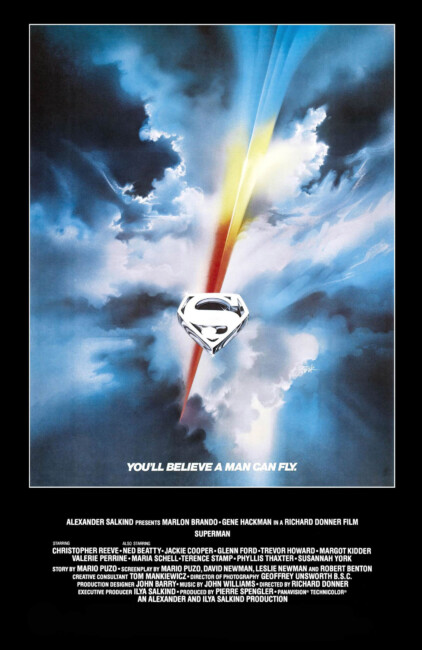UK. 1978.
Crew
Director – Richard Donner, Screenplay – Robert Benton, David & Leslie Newman & Mario Puzo, Story – Mario Puzo, Based on the Comic-Book Created by Joe Shuster & Jerry Siegel, Additional Material – Norman Enfield, Creative Consultant – Tom Mankiewicz, Producer – Pierre Spengler, Photography – Geoffrey Unsworth, Additional Photography – Alex Thomson, Music – John Williams, Zoptic System – Zoran Perisic, Flying Systems/Process Photography – Wally Veevers, Model Supervisor – Derek Meddings, Additional Model Effects – George Gibbs & Brian Smithies, Special Effects – Colin Chilvers, Makeup – Stuart Freeborn, Production Design – John Barry. Production Company – Alexander & Ilya Salkind/Dovemead.
Cast
Christopher Reeve (Superman/Clark Kent), Margot Kidder (Lois Lane), Gene Hackman (Lex Luthor), Marlon Brando (Jor-el), Jeff East (Young Clark), Valerie Perrine (Eve Teschmacher), Ned Beatty (Otis), Glenn Ford (Jonathan Kent), Jackie Cooper (Perry White), Phyllis Thaxter (Martha Kent), Susannah York (Lara), Terence Stamp (General Zod), Marc McClure (Jimmy Olsen)
Plot
The scientist Jor-el tries to convince the ruling council of the planet Krypton that their world is about to crash into the sun but his entreaties are dismissed. Jor-el builds a capsule, launching his baby son Kal-el in it just as the planet is destroyed. The capsule lands on Earth where the baby is found and adopted by Jonathan and Martha Kent, who name him Clark. On Earth, Kal-el’s greater mass gives him incredible powers, including super-strength, near invulnerability and the ability to fly. Growing into manhood Kal-el, or Superman as he calls himself, decides to use his powers for good as guided by educational recordings left by his father. In the guise of the klutzy, bespectacled Clark Kent, he gets a job with The Daily Planet newspaper in Metropolis. There he becomes attracted to fellow reporter Lois Lane, although she only has eyes for Superman. Ruthless real-estate developer Lex Luthor has devised a plan to drop nuclear warheads on the San Andreas fault-line thus dumping California into the ocean and making his Nevada real-estate the most valuable beach-front property in the world. Luthor sees Superman as a threat to his plan and undertakes to get rid of him.
The character of Superman first appeared in Action Comics #1 in 1938, as created by Jerry Siegel and Joe Shuster, two friends just out of high-school in Cleveland. The character exploded off the comic-book page and in almost no time gave birth to not only the notion of the superhero but also of the industry of the comic-book as an independent publishing entity outside of the Sunday newspaper pages. Moreover, Superman created the essential tropes that would be identified with the superhero – superhuman powers, the fight for good and of course the secret identity (although no superhero ever had as uniquely disparate a difference between the fantasy of superhuman abilities and being an ungainly bespectacled klutz as Superman/Clark Kent). Today, Action Comics #1 is the most valuable of all collectible comic-books and the superhero comic-book has become a multi-million dollar industry. (Sadly, it is one that Jerry Siegel and Joe Shuster saw little of – they sold their copyright on Superman to DC Comics and received only a few hundred dollars).
Superman quickly made his way onto the cinema screen. First there was a series of 17 Superman animated shorts produced by Fleischer Studios between 1941 and 1943. There were two serials made during the 1940s, Superman (1948) and Atom Man vs. Superman (1950) starring Kirk Alyn. There was a later low-budget feature film Superman and the Mole-Men (1951), which became the basis of the long-running tv series Adventures of Superman (1952-8) starring George Reeves. Although well-remembered by fans, the serials and tv series are bland – there is little in the way of special effects and all science-fictional elements other than the basic premise have been dropped, with Superman invariably taking on mobsters and petty crime instead of super-villains and intergalactic menaces.
In the 1970s, father and son producing team Alexander and Ilya Salkind decided to make this epic new version. Superman was mounted as an epic in every sense of the meaning. The Salkinds had previously had great success with their version of The Three Musketeers (1973), where so much material had been shot that they were able to cut the film in half and release the rest as a sequel The Four Musketeers (1974). This time they decided that they would intentionally shoot two films at once – Superman and the sequel Superman II (1980). They reigned in Mario Puzo, author of The Godfather (1971) novel, to deliver the script, along with Robert Benton, the screenwriter of Bonnie and Clyde (1967), Kramer vs Kramer (1979) and David Newman, the screenwriter of Bonnie and Clyde, What’s Up Doc? (1972), and both authors of the Superman Broadway play It’s a Bird, It’s a Plane, It’s Superman (1966) for rewrites.
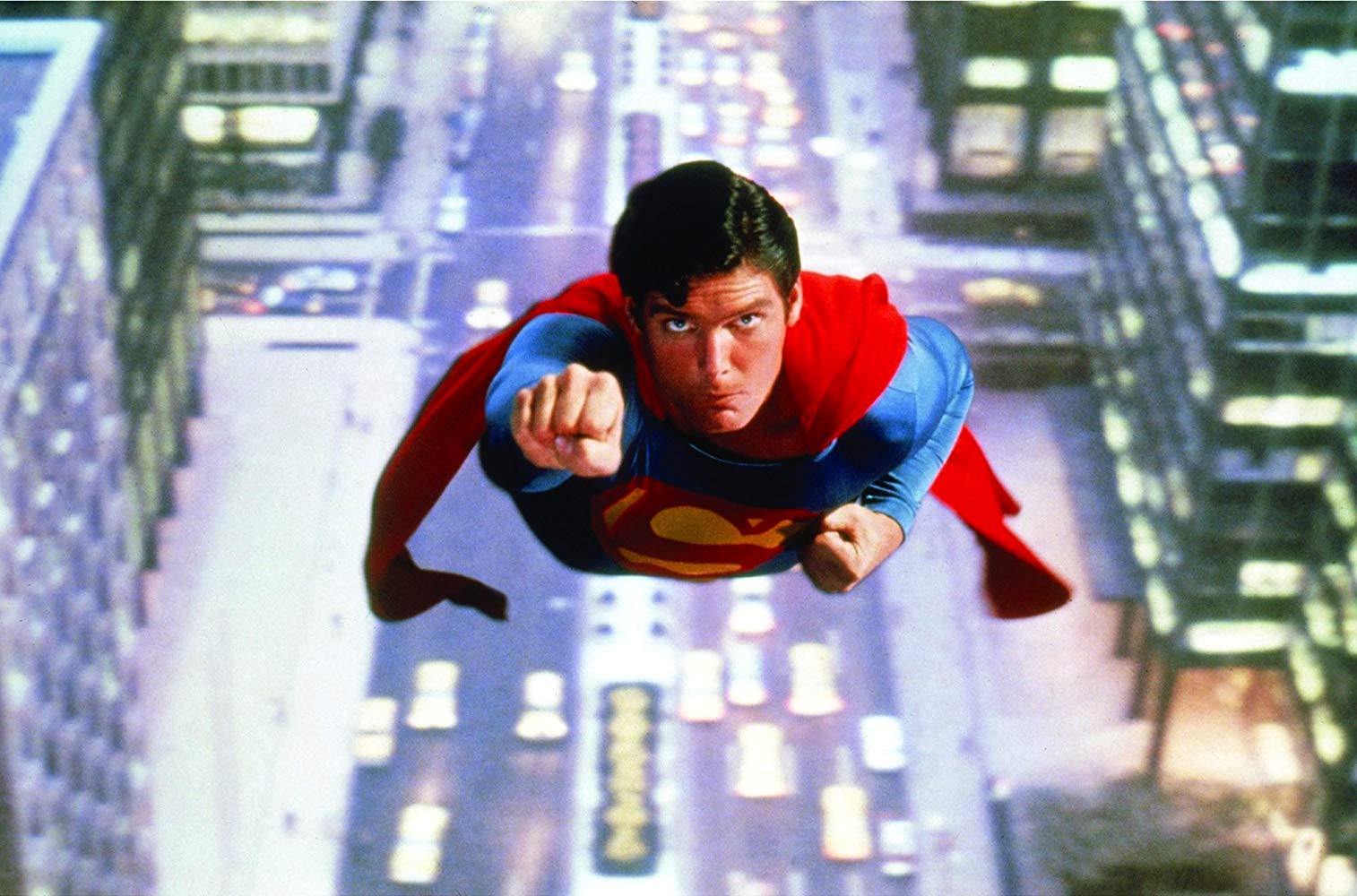
The Salkinds then brought in a massive cast line-up, including Marlon Brando, who the Salkinds paid $3.7 million for 13 days work and a ten-minute screen appearance, which was at the time a world record for the highest salary paid to an actor. Even minor parts were filled with names like Trevor Howard, Maria Schell, Susannah York and Harry Andrews who have only a few lines between them, and a non-speaking cameo from Rex Reed. (You can also see a pre-Dallas (1978-81) Larry Hagman in a small role as the major heading an Army convoy who comes across Valerie Perrine on a bridge. In some versions of the film seen on tv, Kirk Alyn and Noel Neill, respectively the serial Superman and the Lois Lane from the George Reeves tv series, play the parents of a young Lois Lane who see Clark running at super-speed outside the window of a train). At one point, it had even planned that the film would end with a hologram of Superman flying out into theatres.
The Salkinds went everywhere to find a top drawer director for the project, having at one time considered Steven Spielberg. They then settled on Guy Hamilton, director of several James Bond films, including the classic Goldfinger (1964). Several sets for the Guy Hamilton version were built in Rome but this production fell through. The project was then inherited by Richard Donner who was selected by the Salkinds after he became a hot name with the runaway success of the Anti-Christ film The Omen (1976).
The production of Superman was heavily laden with problems. The relationship between Richard Donner and the Salkinds was not a harmonious one and when it came to the completion of the sequel, the Salkinds fired Donner and had the job completed by Musketeers director Richard Lester. Casting problems occurred – Jackie Cooper came in as Perry White on only a day’s notice after original casting choice Eddie Albert had to drop out for health reasons. Shooting slowed down until the point where only 30 seconds of film was being shot a day. These productions delays were such that the completion of Superman II was shelved after being only 30% completed (accounts vary) in order to concentrate on this film’s release date. Both Mario Puzo and Marlon Brando also sued the Salkinds for non-payment of fees following the film’s release.
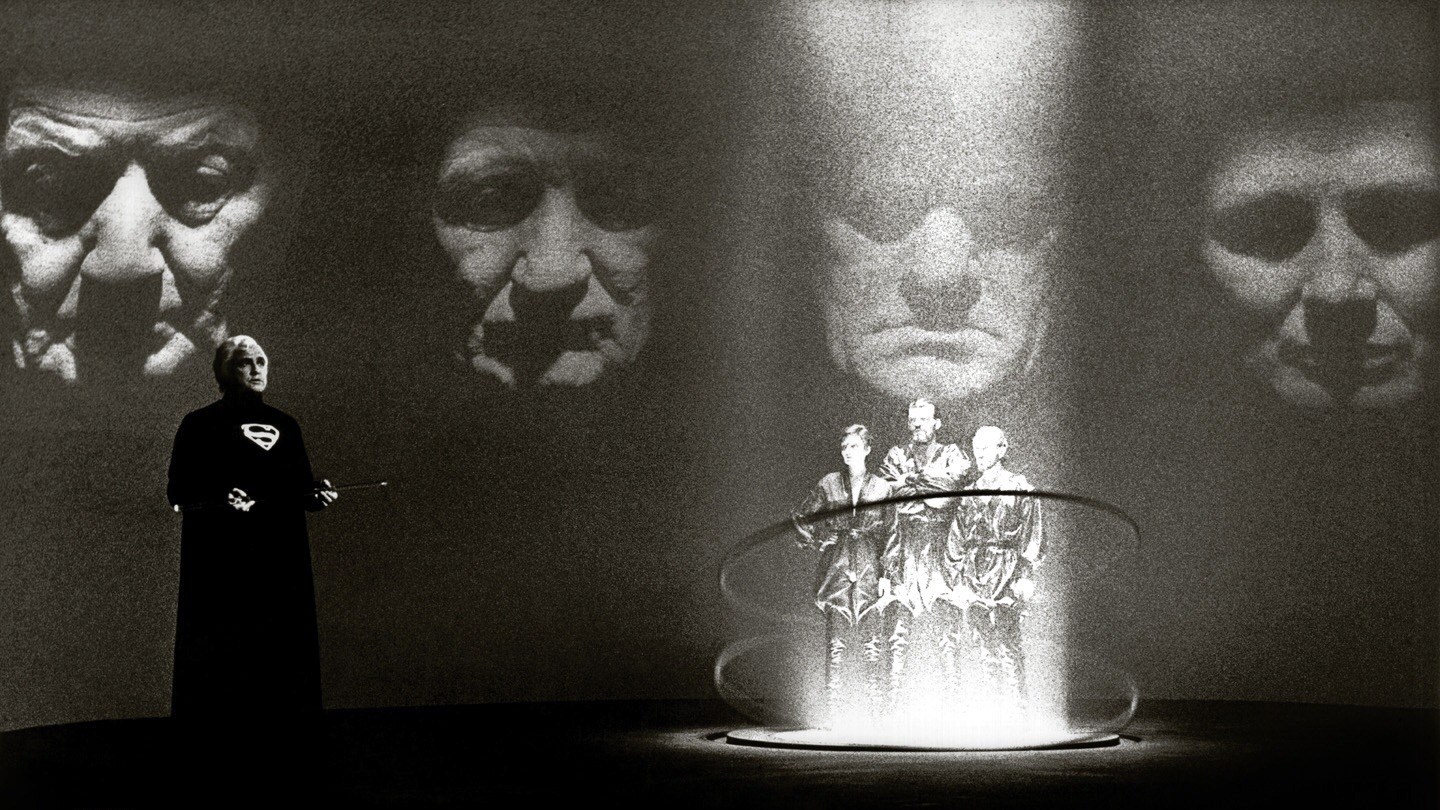
Comic-books had not been that successful on screen before Superman. There were a number of comic-book characters that had been adapted to the screen during the era of the serials – Dick Tracy (1937), Adventures of Captain Marvel (1941), Batman (1943), Captain America (1944), the aforementioned Superman serials. However, these were cheap productions, where the fantastique had been compromised by budget and a prosaic dullness in opening up and letting the superheroes be super – the most heroic exploits ever got was the serial Superman swinging on a crane or lifting a truck. (The sole exception in regard to successful comic-book adaptations would be the non-superheroic Flash Gordon serials). A second wave of screen superheroes came in the 1960s after the success of tv’s Batman (1966-8) but the tv Batman defined the mode of the superhero as camp where all the heroic epithets and po-faced seriousness of the comic-book originals was played for maximum silliness. The Salkind-Donner Superman could be measured as the demarcation point where cinematic superheroes started to be taken seriously on screen. A much greater budget allowed Superman to fly with a full flight of fantastic imagination and the results are a simply marvellous incarnation of a comic-book. This, Tim Burton’s two Batman films, Batman (1989) and Batman Returns (1992), The Crow (1994), X-Men (2000) and The Dark Knight (2008), would have to count as the handful of great comic-book to film adaptations.
It wasn’t always the case with Superman though. Original treatments of the script fell into the Batman tv mode. One infamous scene in Mario Puzo’s script had Lex Luthor encountering Telly Savalas as Kojak in a railway station who then offers Luthor a lollypop and tosses off his trademark line “Who loves ya, baby?” Reportedly it was Richard Donner who toned the camp elements down, although some of this still remains with the playing of Luthor and assistants. Luthor survives okay, thanks to the usually excellent Gene Hackman in the role, but the film surrounds him with a bimbo and an annoyingly buffoonish performance from Ned Beatty as his dim-witted assistant. Otherwise though, the film is remarkably successful.
The film takes some liberties with the comic legend but often for the better. The idea of the ‘S’ that Superman wears on his chest now ingeniously becomes a family crest, which makes it less egotistical than in the comic-book. The film also abandons the Grecian-styled look of Krypton from the comic-book and instead crafts Krypton as a beautifully ethereal white-on-white world of crystal, lorded over by a regal, mellifluous Marlon Brando. The film has a stunning sense of otherworldly spaciousness in these scenes. The film also changes the characterization of Lex Luthor from what he was in the comic-book, turning him from a brilliant criminal scientist into a plutocrat. (Interestingly, this is a characterization that was later copied by DC Comics in their post-Crisis Universe and all subsequent portrayals of Luthor on tv – see below). This Luthor also has hair rather than being bald, although Gene Hackman does whip his wig off in the very last scene (purportedly because Hackman refused to shave his head). [Luthor’s scheme of blowing the San Andreas fault-line up with a nuclear weapon in order to dump California into the ocean was later reused by the James Bond film A View to a Kill (1985)].
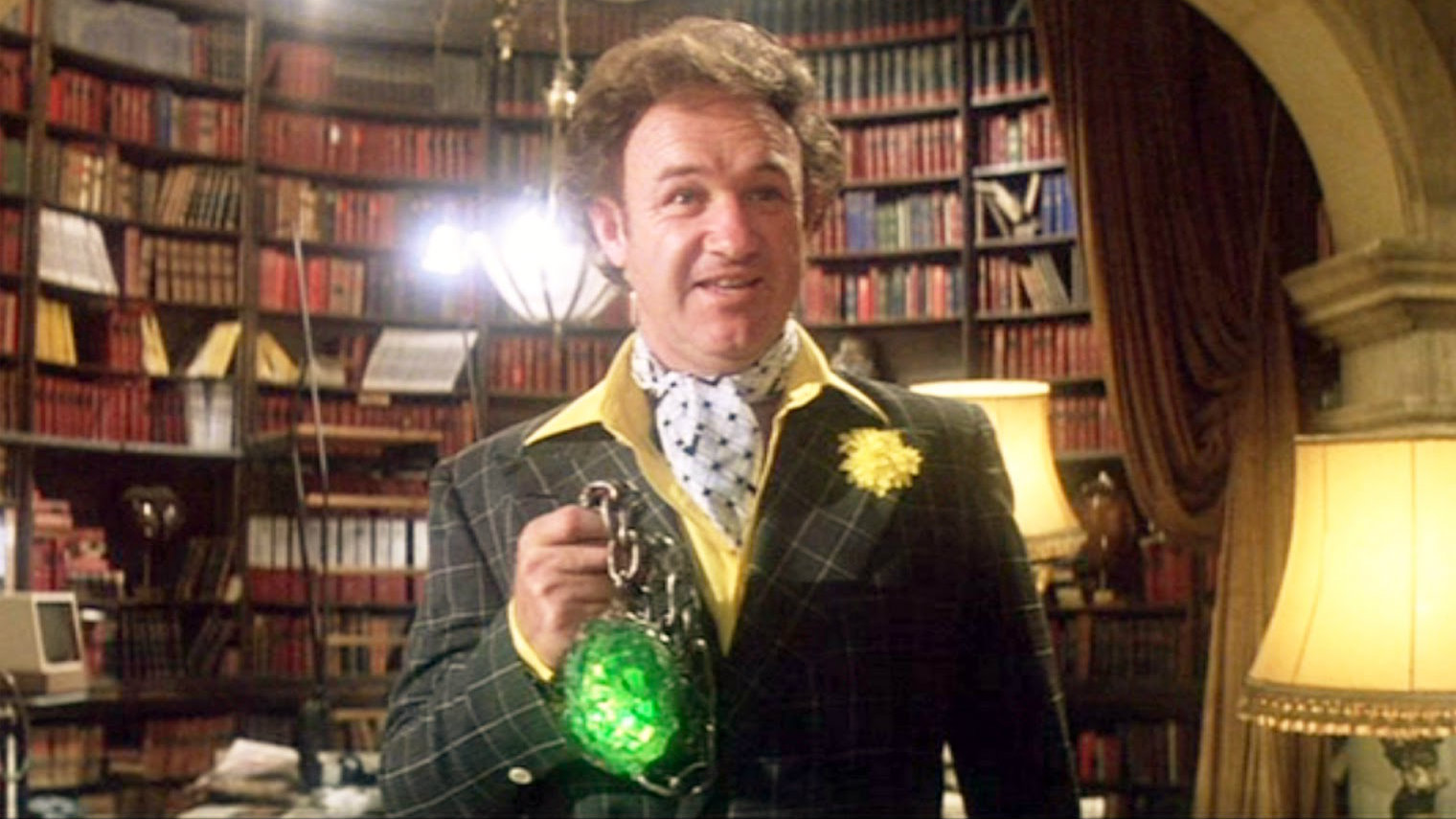
The script does have some illogicities – like a planetful of people who somehow fail to notice that they are about to crash into their own sun. There is not any sufficient explanation of Superman’s powers. Mindedly, the comic-book did not exactly offer a believable explanation either – but this script drops the usual yellow/red sun explanation and offers some nonsense about Superman having denser mass (something that would in actuality make him too heavy to fly). The climactic scene where Superman reverses time by turning the world backwards, while it contains an epic feat of superheroism, is something that in practicality would cause everything not nailed down to go flying off in the opposite direction.
Part of the problem with Superman is that it has too many cooks involved in the broth. There are times that it feels like several different films run together. The film’s style seems to change from one sequence to the next – the Kryptonian scenes in the first 45 minutes have a beautifully spacious mysteriousness; by contrast, the Smallville scenes evoke the pastoral lyricism of a Norman Rockwell American heartland; and finally the film turns camp in the Luthor scenes. The miracle is that despite all of this, Richard Donner wields it together into a magnificent and satisfying whole. It achieves its minor excesses of sentiment – Lois Lane’s voice-overs during the night-flight across Metropolis with Superman are dreadfully mushy, and Phyllis Thaxter as Martha Kent’s comment “We’ve prayed to the Lord to send us a child” upon finding the baby Kal-el in a spaceship plays a little too straight-facedly on the film’s conscious sense of its own cod-Christian mythology. However, none of the other Superman films achieve such an epic scope, nor such an aching lost childhood sense of purebred red, while and blue American innocence. When we see Christopher Reeve in his Superman costume for the first time and he takes off into the air flying straight into and over the camera, the result is exhilarating.
The Salkinds spent a long time trying to cast the lead. Everybody was considered from Arnold Schwarzenegger and Sylvester Stallone to Warren Beatty, Robert Redford and Olympic gold-medal pentathlete Bruce Jenner. Thankfully some of these choices were passed over – one cringes to think what the project would have been with Schwarzenegger or Stallone in the role. The actor finally chosen was Christopher Reeve. 27 year-old Christopher Reeve was a total unknown at the time – he had only appeared on the soap opera Love of Life (1951-80) and had a minor part in the disaster movie Grey Lady Down (1977) – and was propelled from nowhere into superstardom. Christopher Reeve makes a warm, wonderfully human Superman. He plays the part as a totally square boy scout, full of unbelievable good cheer. He is the ultimate in sensitive romantic males – which is where the film’s conviction comes from.
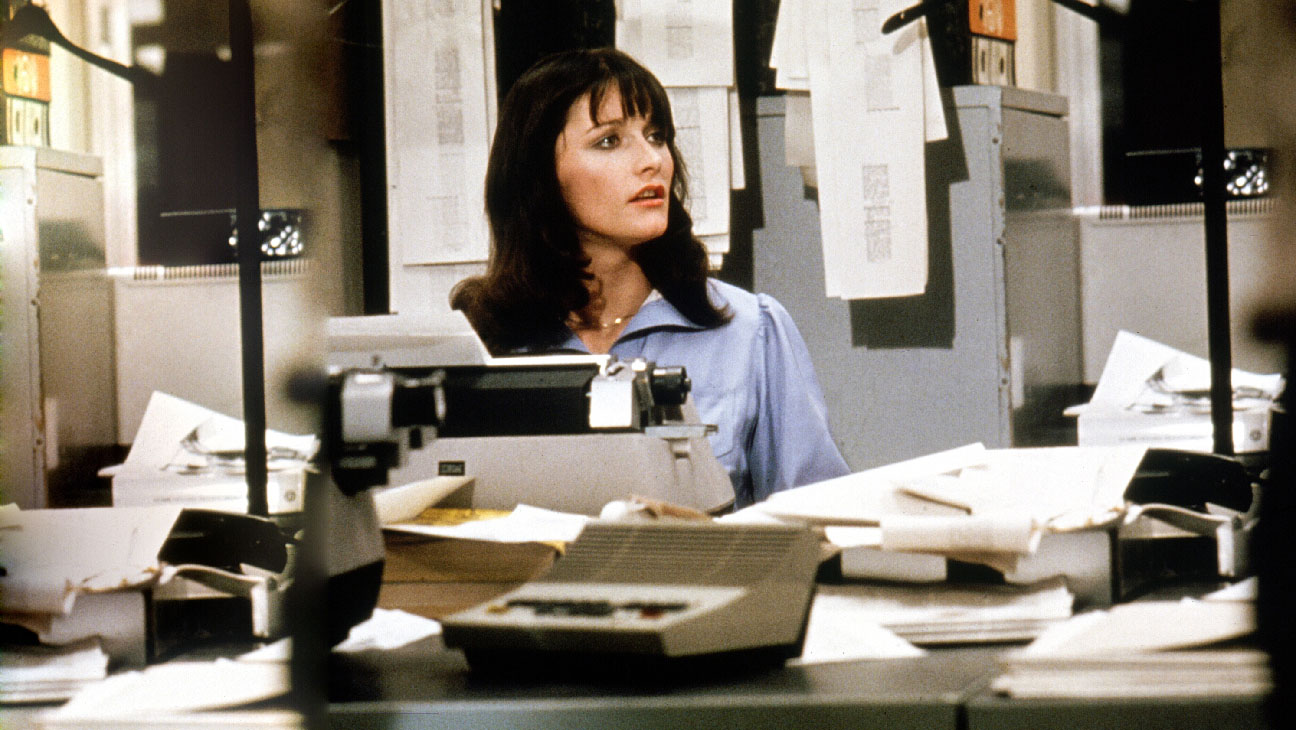
The special effects are excellent – as the publicity machine promised “You will believe a man can fly.” Yugoslav front projection specialist Zoran Perisic invented a new special effects system – the Zoptic Process – that allowed matte work of a flying Christopher Reeve to be placed in relation to background processes that could be focused in and out on. Sometimes the effects look a little hokey – there is a big wire visible just before the dam blows – but mostly the work is stunning. John Williams, who had just done similar duties for the previous year’s two big science-fiction hits, Star Wars (1977) and Close Encounters of the Third Kind (1977), turns in a stirringly epic score.
In some ways, Superman was an echo of the times. One of the most prevalent genres of the 1970s was the disaster film where humanity was constantly being reminded of its fallibility as colossal size man-made structures were being rendered as rubble, perhaps a reminder of the social turmoil of the preceding decade. Where disaster movies were giant spectacles in which humanity was constantly humbled by natural disaster and accident, Superman is cast as a heroic paragon of good that can stand up to such disasters. The epic-size climax has him turning nuclear missiles in their path, acting as a bridge for a collapsed rail line, welding tectonic plates back together and even reversing the world and turning back time for the sake of love – a feat no other superhero film has managed to copy in scale. Both Superman and Star Wars marked a move away from the defeatism of the disaster spectacle and a return to black-and-white morality. They were, in a sense, a reclaiming of America. As the warden of the jail (where Superman delivers Luthor seemingly without even the benefit of a trial at the end of the film) says, “With you here, this country is safe again.” It was a change mirrored in the real world – Ronald Reagan sailed into the White House in 1980, just like Superman does here, consciously crafting himself as an upholder of old-fashioned decency and moral values.
Superman was followed by three sequels – Superman II (1980), Superman III (1983) and Superman IV: The Quest for Peace (1987). The Salkinds also made Supergirl (1984) from the comic-book featuring Superman’s cousin and the tv series Superboy (1988-91). Superman II is fine but quality of the series plummeted drastically with Superman‘s III and Supergirl. The Salkinds then sold off interest to Cannon who produced the cheap Superman IV, which has some moments of interest. Richard Donner later placed his original intended vision of Superman II, which had been subject to much in-fighting with the Salkinds, together as Superman II: The Richard Donner Cut (2006). For much of the 1990s, a Superman movie revival was planned, with various ideas and names being attached, before it finally emerged as Bryan Singer’s excellent Superman Returns (2006), which does an amazing job of continuing on from the first two Salkind films. There was also Superman: Requiem (2011), a feature-length fan film that was sanctioned by Warner Brothers starring Martin Richardson as Superman, which pays much tribute to and directly carries on in continuity from the Reeve films. Also of note is the South Korean A Man Who Was Superman (2008), a film about a man who believes he is Superman, which quotes several scenes from this film, and Super/Man: The Christopher Reeve Story (2024), a documentary about Christopher Reeve’s life after the horse-riding accident that left him paralysed.
Richard Donner went on to make a number of other genre films, including the fine Mediaeval romantic fantasy Ladyhawke (1985), the updated Dickens tale Scrooged (1988), the interestingly dark children’s film Radio Flyer (1992), the dud comedy Conspiracy Theory (1997) and the dull Michael Crichton-adapted time travel film Timeline (2003). In the 1990s, Donner turned out endless sequels to his Mel Gibson hit Lethal Weapon (1987) and flops like Assassins (1995). Donner also acts as producer on The Lost Boys (1987), the Tales from the Crypt cable anthology series (1989-96), Delirious (1991) about a writer trapped inside his own soap opera, the monster hunter film Matthew Blackheart (2002), the voodoo film Ritual (2002), and the comic-book adaptations X-Men (2000), Constantine (2005), X-Men Origins: Wolverine (2009) and X: First Class (2011). Donner has also been attached to a number of interesting sounding projects in recent years including the live-action adaptation of Speed Racer (1967-8) and a remake of The Quatermass Xperiment (1955).
The Salkinds fairly much vanished as a producing force after the Superman films. They went on to conduct two other ventures into legend with Santa Claus – The Movie (1985) and Christopher Columbus: The Discovery (1992), both of which were widely regarded as total disasters. Their one other genre production was the campy costume drama version of the fairytale Bluebeard (1972) about a multiple wife murderer starring Richard Burton.
Other Superman appearances on screen are:-
- seventeen Superman animated shorts produced by Fleischer Studios between 1941 and 1943
- two serials made during the 1940s, Superman (1948) and Atom Man vs. Superman (1950) both starring Kirk Alyn
- the low-budget feature film Superman and the Mole-Men (1951), which became the basis of the long-running tv series Adventures of Superman (1952-8) starring George Reeves
- It’s a Bird … It’s a Plane … It’s Superman (1975), a tv movie adapted from a Superman Broadway musical starring David Wilson
- Lois and Clark: The New Adventures of Superman (1993-7), a popular tv series that focused more on the love triangle relationship between Clark/Superman (Dean Cain) and Lois Lane (Teri Hatcher)
- the excellent animated series Superman (1996-2000) where the superheroic exploits were rendered in a beautifully stylised Art Deco milieu, which led to several spinoff films with Superman: The Last Son of Krypton (1996), The Batman Superman Movie: World’s Finest (1998) and Superman: Brainiac Attacks (2006), while Superman also appears as one of line-up of DC superheroes in the same creative team’s Justice League/Justice League Unlimited (2001-6)
- The DC Universe Original Animated Films:- Superman: Doomsday (2007), Superman/Batman: Public Enemies (2009), Superman & Batman: Apocalypse (2010), All-Star Superman (2011), Superman vs. The Elite (2012), Superman Unbound (2013), The Death of Superman (2018), Reign of the Supermen (2019), Superman: Man of Tomorrow (2020), Superman: Red Son (2020) and Batman and Superman: Battle of the Super Sons (2022), while Superman also appears in Justice League: The New Frontier (2008), Justice League: Crisis on Two Earths (2010), Justice League: Doom (2012), Batman: The Dark Knight Returns Part II (2013), Justice League: The Flashpoint Paradox (2013), Justice League: War (2014), Justice League: Throne of Atlantis (2015), Justice League: Gods and Monsters (2015), Justice League vs Teen Titans (2016), Justice League Dark (2017), Justice League vs The Fatal Five (2019), Justice League Dark: Apokolips War (2020), Injustice (2021), Justice Society: World War II (2021), Justice League: Warworld (2023), Legion of Super-Heroes (2023), Justice League: Crisis on Infinite Earths Part One (2024), Justice League: Crisis on Infinite Earths Part Two (2024) and Justice League: Crisis on Infinite Earths Part Three (2024)
- the tv series Smallville (2001-11) played by Tom Welling, which concerns Superman’s teen years
- Zack Snyder’s reboot Man of Steel (2013) starring Henry Cavill and its follow-ups, the DC superhero team-ups Batman V Superman: Dawn of Justice (2016) and Justice League (2017) and the extended cut of the latter with Zack Snyder’s Justice League (2021), while Cavill also makes a cameo in the end credits of Black Adam (2022)
- the tv series Supergirl (2015-21) starring Melissa Benoist with appearances from Tyler Hoechlin as Superman who was later given his own series with Superman and Lois (2021-4)
- the prequel tv series Krypton (2018-9) concerning Superman’s grandfather before the destruction of Krypton
- the animated tv series My Adventures with Superman (2023- )
- Superman also turns up as an animated character in Legion of Superheroes (2006-8), The Lego Movie (2014), The Lego Batman Movie (2017), Teen Titans Go! To the Movies (2018), The Lego Movie 2 (2019) and DC League of Super Pets (2022), while the animated series Young Justice (2010-3) features Superboy, a clone of Superman, as a regular character
- Also of interest is The Death of “Superman Lives”: What Happened? (2015), a documentary about the aborted Tim Burton-Nicolas Cage Superman film of the late 1990s, and the South Korean A Man Who Was Superman (2008) about a man who believes he is Superman.
Trailer here


